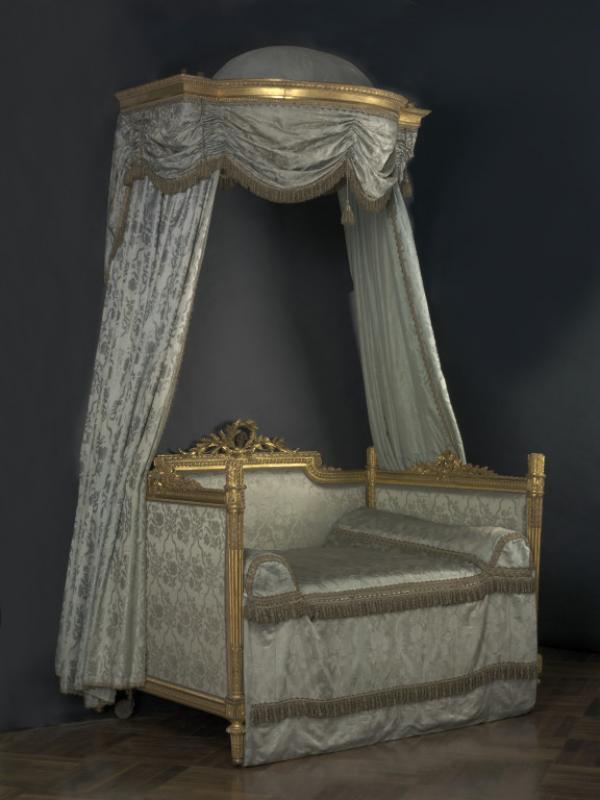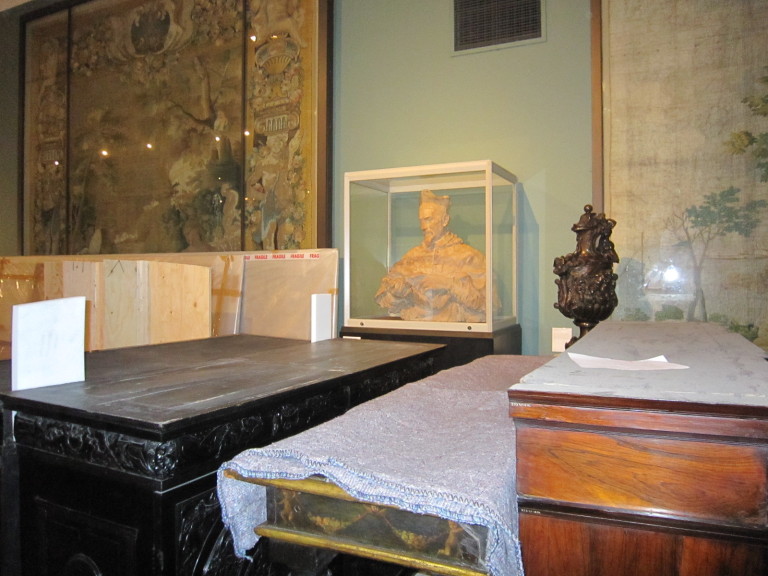This second blog entry follows the exciting (and relieving!) recent news that our project has been successful in our bid to the HLF (Heritage Lottery Fund) for funding to support the completion of the galleries. As well as a reason for celebration, this achievement provides a good moment to briefly reflect on how far the project has already come since its initial inception back in November 2009.
The most visible development is of course to the physical space of the galleries. The galleries previously contained about 900 objects on display and featured installations of period rooms consisting of hundreds of individual pieces. Back in 2011, all of these objects were decanted from the galleries and safely moved into secure storage. This operation was a massive undertaking, involving many people from across the Museum.
The galleries contained a great variety of objects, in terms of style, technique, materials and (most notably) size. From this small Meissen salt cellar, just 14 cm tall high, to large pieces of furniture such as the Jacob bed, everything had to be removed.
![Salt cellar, Meissen Porcelain Factory, ca.1761 [C.252-1921]](https://s3-eu-west-1.amazonaws.com/vam-blog/dp-content/14075afdffe5003b817d2302612530b7.jpg)
Salt cellar, Meissen Porcelain Factory, ca.1761 [C.252-1921]

Bed (‘Lit à la polonaise’), Stamped ‘G. JACOB’, French (Paris), about 1780 [8459-1863]
Some of the objects will return to the new galleries but there will also be some new selections making an appearance in 2014.
The decant required Collections [the departments that are responsible for specific collections of objects within the Museum, e.g. Furniture & Woodwork] to identify adequate space to store all of the objects whilst the galleries are being renovated and beyond. With space in the Museum at a premium and so many objects to house, this was a challenge at times.
Assessing & Preparing Objects
Curators and conservators assessed the condition of each object to determine the safest method to move it. These assessments involved identifying vulnerable elements that could be put at risk by movement: weak points in sculptures, loose paint or varnish on surfaces, movable parts (such as drawers that might rattle).
Many of the objects were stable enough to be transported simply by trolley or basket into on-site storage.

Here museum staff are removing two brightly coloured 17th century chasubles [243-1895 & T.295-1972] from their display case. Val (on the right) is from our Conservation Department. The chasubles were moved to an area with brighter lighting so that Val could examine them for any sign of deterioration and also advise on how best to store them.
And here they are later, looking very anonymous and rather mysterious, covered in protective Tyvek in temporary storage.

For those objects that had unstable elements, or needed to be moved to off-site storage, conservators worked to stabilise them and our technicians and packers created custom-built packaging to support and protect them during transportation.

Two French 18th century marble statuettes representing summer and spring, in the process of being crated for their journey [1180&1179-1882]
![1-1979]](https://s3-eu-west-1.amazonaws.com/vam-blog/dp-content/a651d4cd88dfb36385e25afbcb0f6f4c.jpg)
Bureau cabinet, Dresden, 1745 to 1749 [W.62:1-1979]
This blue and gold japanned bureau needed to have a consolidant applied to unstable areas of its surface. Consolidants are substances used to bind together parts of an object in order to stabilise them and avoid any deterioration. The substance used on the bureau contained a solvent and so a portable extractor was needed to remove solvent vapours from the atmosphere, this is the machine positioned in the foreground.
![Teracotta bust of Cardinal Paolo Emilio Zacchia [A.78-1970]](https://s3-eu-west-1.amazonaws.com/vam-blog/dp-content/cdf51756c6b735f1ab9cf95b8b28201d.jpg)
The mid-seventeenth century teracotta bust of Cardinal Paolo Emilio Zacchia [A.78-1970] appeared to be keeping a close eye on our furniture moves.
The photograph below shows some of our 18th century French furniture secured onto pallets with custom-made frames to hold them in place and temporary protective plastic sheeting covering them.

Period Rooms
The galleries contained a number of period rooms, such as the one from the Manoir de La Tournerie. The term ‘period room’ is used for historical period interiors that have been installed within a space to suggest how they would have originally been experienced. The photographs below show the room from the Manoir de La Tournerie in the galleries just before it was dismantled.
![Part of the room from the Manoir de La Tournerie, French c. 1682-94 [881-1903]](http://www.vam.ac.uk/b/sites/default/files/styles/mu_blog_image/public/blog_images/2012FR5318.jpg)
![Part of the room from the Manoir de La Tournerie, French c. 1682-94 [881-1903]](https://s3-eu-west-1.amazonaws.com/vam-blog/dp-content/8951f32ae95540f415ccb06188badd97.jpg)
Room from the Manoir de La Tournerie, French c. 1682-94 [881-1903].
And here is part of the same space once all of the room parts had been removed.

These are just a few of the many parts that make up the room.

As the room was dismantled, all of the parts were laid out, clearly numbered and documented before being packed for storage. The material that looks like white tissue paper is in fact a tissue made of hemp which is applied to the painted and gilded panels by Conservators in order to protect the surface.

These are some window pane and shutter panels also from the room. They are raised up on and separated by white blocks of plastizote, which keeps them in place and provides a cushioned support that won’t damage the surface of the objects. Each piece has a label attached detailing its museum number.
Every object in the V&A’s collections has its own unique museum number. For objects that consist of a number of pieces that can separate, each piece is given an additional ‘part number’. The overall museum number for the La Tournerie room is 881-1903 and every single one of the 162 pieces that make-up the room (including: dados, mouldings, panels, paintings and floorboards) has its own part number. For example, part number 881:5-1903 is a doorjamb and 881:162-1903 is one of the ceiling beams.
Furniture Stores
All of the Museum’s furniture that is not on display or out on loan is kept in our furniture stores at Blythe House, Kensington Olympia. As the Europe Project Team is part of the Furniture, Textiles & Fashion department, we were heavily involved in organising and overseeing the movement of furniture from the galleries to Blythe House.

Blythe House, Kensington Olympia
The bronze cherub on this secretaire is waiting to be re-housed in surroundings rather different to those it would have seen in the late 18th century.
![Upright Secretaire, French (Paris), 1774 [W.17-1970]](https://s3-eu-west-1.amazonaws.com/vam-blog/dp-content/3fca833bdc5912aad3477b05210d77bf.jpg)
Upright Secretaire, French (Paris), 1774 [W.17-1970]
The photograph below shows two pieces of furniture installed in their new home on the racked storage. Here you can see how each piece had a tailor-made frame created, specific to its design, to ensure that it was carefully supported. The white blocks of plastizote are used to provide a cushioned support between the object and the frame.

Revealing the Aston Webb Architecture
Once all of the museum objects had been safely removed, contractors were able to move in to start the next stage of the galleries’ transformation. They removed the old cases, walls, false ceilings and other fittings, stripping the galleries right back to their original Aston Webb architecture. The change to the space was dramatic, as the true size of these grand rooms was once again revealed and sunlight shines down through the large windows.


